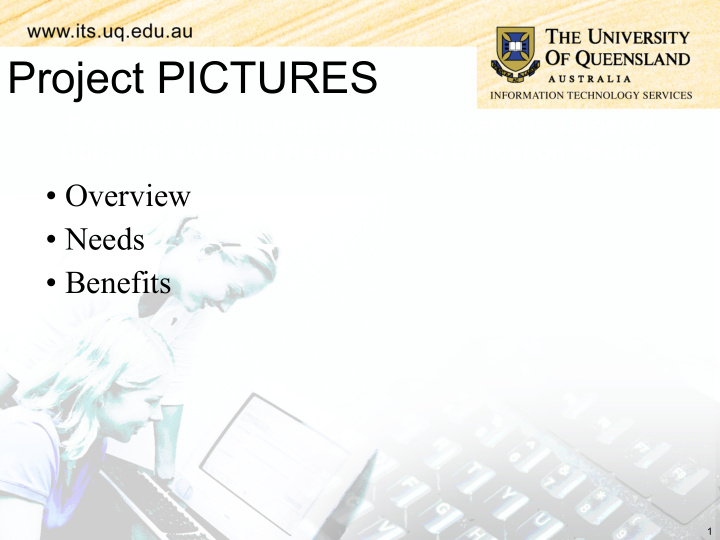



Project PICTURES Presence and Integrated Communications Targeted Ubiquitously to the Research and Education Sectors • Overview • Needs • Benefits 1
Project PICTURES What's in a name? • Presence and • Integrated • the Research and • Communications • Education • Targeted • Sectors • Ubiquitously to 2
Overview • Aimed at lowering and overcoming communication barriers between research collaborators • By growing a pervasive Presence, Instant Messaging and VoIP fabric . – Based on XMPP and SIP. – Targeted at the Higher Education and Research sectors. – Reaching out and touching all researchers, academics and students in these communities. • Focused not on the meeting paradigm. – But efficiently enabling the informal and impromptu interaction for which initiating a meeting represents an unnecessary barrier. – Alongside and interoperable with typical meeting enabling technologies. • Access Grid, H.323, VRVS, EVO, ... 3
Needs • Email still a significant component in collaboration, but ... • More modern communication technologies are eating away at its dominance. In particular: – Presence – Instant Messaging – Voice and Video • These are becoming crucial in the process of collaboration between researchers, academics and students. But ... • Seeing similar interoperability pains that accompanied the birth and adolescence of email. – Different protocols and limited points of interoperability. • These pains will just intensify as more collaborators are working in VOs – cross institutional, interstate and international boundaries. • Need to overcome collaboration barriers until the problem is fixed. 4
Benefits: Enhancing Communication Productivity • Many studies identified how a Presence and Integrated Communications infrastructure can promote enterprise productivity benefits – An average 32 minutes/day saved by knowing the best way to reach a collaborator. – An average 31 minutes/day saved by reaching a collaborator via Instant Messaging. – An average 53 minutes/day saved by escalating an IM session to voice/video conversation. – 59% of workers save more than 15 to 30 minutes/day reaching collaborators using a single communication identifier regardless of location. 5
Benefits: Enhancing Communication Productivity – US$1727/month/travelling-employee saved due to saving long distance, hotel phone and cell phone charges. – 83% of workers say it would be useful to see each others’ status prior contacting them. – 27% of enterprises have daily or weekly project delays due to difficulties in reaching key decision makers. – 88% of enterprises say projects slow down or stop due to delays in reaching key decision makers These benefits can be translated to the Higher Education and Research sectors as a whole for the benefit of researchers, academics and students alike. But only if collaborating entities are “connected” over a PIC fabric(s). 6
Benefits: Bridging Communication Silos 7
Benefits: Bridging Communication Silos Why create yet another PIC fabric? – Aren't MSN, AIM/ICQ,Yahoo!, Skype, ... pervasive enough? • No. Its all about improved connectedness between participants. – Telephone is near pervasive. • 99.999% chance that any 2 people can start collaborating (once communication identifiers discovered). – Email is similar high. – But MSN, AIM/ICQ, Yahoo!, Skype, ... are (mostly) non-interoperable silos. • People need accounts in each of their collaborators' technology silos. – Another collaboration barrier to overcome. 8
Benefits: Bridging Communication Silos • Discipline and Institutional Silos exist too. – Research groups and some research disciplines (eg. HE Physicists) tend to use a particular collaboration tool. – An institution may have already deployed an enterprise-level PIC fabric which may not “connect” with other PIC fabrics. • What if they want to “cross-fertilize” with other disciplines/institutions. – Another collaboration barrier to overcome. 9
Benefits: Communication Layer Security • Various PIC fabrics have varying degrees of security. – Both at application and protocol levels. • Understanding of risks can be obfuscated . – Due to the proprietary nature of the application and protocol. • Open standards like XMPP and SIP promote better understanding of risks and transport security. – C2S, S2S and E2E. – TLS and SRTP. 10
Benefits • Strong Identity Management – Most commodity PIC fabrics employ non-existent or weak identity management. – Introduces some risk concerning with whom you are collaborating, unless it is by voice or video. – All identities within this proposed fabric are managed either by a university, a research institution or similar body. • Participants in intra- fabric communications are well identified. • Other benefits – fabric will also provide a pervasive, secure and cost effective MOM layer. • Application level messaging across institutional boundaries. 11
Recommend
More recommend